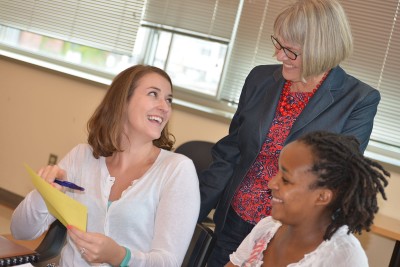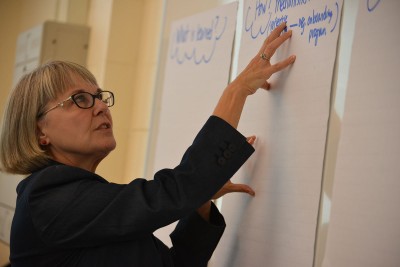
Marijke Kehrhahn, who returned to faculty this fall after serving in administration in the Neag School of Education for 10 years, talks about her past experiences and future plans.
Q: What did you like best about serving as the associate dean?
I really liked having access to the ‘whole school’ perspective and to have the opportunity to be engaged in projects that would have an impact on the school level and the university level. As a faculty member, my interests and influences were at a more local program and department level. One example was setting up and leading the Neag Leadership Academy. I really enjoyed working with department heads to identify potential future leaders and to facilitate the yearlong cohort of future leaders. Some good leaders came out of that group – Sandy Chafouleas, Morgaen Donaldson, Betsy McCoach, and David Moss!
Q: What would you say were your proudest moments/biggest accomplishments during the five years?
I think it has to be working with the dean to get approval for two cluster hires and then successfully filling those positions, as well as recruiting and hiring some stellar senior faculty. The recruitment effort and the search process took a lot of focus and a lot of work, and resulted in adding a really terrific group of new faculty to our school. They bring new ideas and at the same time, fit so well with what we are all about as a school.
Q: What was your favorite memory as the associate dean?
Being able to read all the names at Commencement!
Q: During your sabbatical this coming spring in London, what are your plans for research/writing?
After spending ten years in administration in the Neag School, I am way behind on my reading in my field of study, adult learning and workplace learning! I plan to find a cozy chair in the British Library and read, read, read. I am hoping to be inspired by the great British authors and produce four manuscripts for publication, as well. I am seeing my time in London as an urban writing retreat. I am working on plans for a collaboratively developed book on how school leaders can help teachers adopt and integrate new classroom practices into their instructional repertoires.
Q: Having recently returned to faculty after 10 years in administration, what do you look forward to most about teaching?
Well, I’ve been teaching all along, but I do look forward to spending a bit more time with my students than my previous job allowed. I also had to teach at 6:30 pm to have enough time at the end of the administrative day to get ready for class – so I am looking forward to teaching at least some classes at more reasonable times!
Q: What will you miss most about being in administration at the Neag School?
The people – working day to day with the folks in the Dean’s Office was rewarding. It was wonderful to be part of such a smart, thoughtful and enjoyable team. We laughed together, cried together, and sometimes stewed together. These are the people who are here in the Gentry building every day, all year. We developed a bond and while our relationships will certainly remain, I miss our day-to-day interactions.
Q: With the Higher Education and Student Affairs (HESA) program, tell us the international partnership with the University of Glasgow and their future plans?
I’ve enjoyed working with former Provost Peter Nichols and Dr. Sue Saunders to support the HESA International Experience at the University of Glasgow. The HESA “Glasgow 5” did an excellent inquiry project on the use of social media to attract, enroll, and support international students at UG and the Glasgow community of student affairs professional really embraced the HESA scholars. At the moment, U Glasgow continues to be our priority and we plan to continue to nurture and grow our student affairs partnership in a number of ways. Completing a three week international experience is challenging for HESA students, given their assistantship responsibilities here at UConn but we are hoping that we will build enough interest to develop additional sites and are currently focused on UConn’s U-21 partner University of New South Wales in Sydney.
 Q: Outside teaching, what are your top research plans?
Q: Outside teaching, what are your top research plans?
I continue to work on NSF-funded projects on problem-based learning (PBL) in technical education and have just co-authored and submitted another grant, with a research focus on how departments support teachers to integrate new PBL teaching practices into their instructional routines. I am very interested in the process of modifying and innovating work routines, early career development, and organizational learning systems and hope to do more research and writing on these topics. I think my reading during my sabbatical will help me hone in on research ideas that will contribute to the body of knowledge about adult learning in the workplace.
Q: What interests you most about Neag’s new academic vision?
The high level of involvement in crafting the four dimensions of the Neag academic vision resulted in a plan that speaks to the majority of our faculty and students in a real way and shows a path to having a collective impact on the university, the state, and the nation. I look forward to seeing how Neag faculty use their creativity to turn the ideas into action in ways that capitalize on our collective expertise and have a real impact in the field of education.
Q: As a triple UConn alum, how has the academic training helped you throughout your career?
After graduating from UConn with a BFA in Dramatic Arts, I earned two degrees from the Neag School. I earned my Master’s in Special Education in 1980, then worked as a special education teacher in Windham Public Schools and then went on to work for the Connecticut Department of Developmental Services, essentially to resolve the CARC v. Thorne lawsuit and close the Mansfield Training School (now the UConn Depot Campus).
During my Master’s program, I learned from Neag faculty greats – Stan Shaw, Jim Strauch, Mel Reich, AJ “Pappy” Pappanikou, Isabel Liberman, and Miriam Cherkes – who held us to high standards of practice and modeled a capacity-driven mindset about disability that provided me with excellent skills and dispositions for being successful as we all engaged in the work of inclusion and education for all.
As a doctoral student in the Adult and Vocational Education program, under the guidance of another Neag great Barry Sheckley, I was provided with many opportunities to practice academic and research skills and was very well prepared to be a successful faculty member at a Research 1 university.
Q: With your early background as a middle school special education teacher and director of volunteer services for 1995 Special Olympic Games in New Haven, how did those experiences impact your professional career?
My teaching time in the special education classroom changed my life in big ways – each and every student taught me something about life, about interaction, about goals, about collaboration. And although much has changed in the 30 years since I was in the K-12 classroom, my memories of that time connect me to the Neag students of today and fuel the deep respect and admiration I have for them and their desires to change the lives of young people in their care. Honestly, nearly every day I am inspired to tears by the dedication, compassion, and desire to reach every child that is displayed by Neag students. They’re amazing!
My work at the 1995 Special Olympics World Games impacted my career by providing me with a goal that was bigger than anything I had ever done before – so that work was a game changer because it changed the boundaries on what I thought I could accomplish. AND it brought me into day-to-day work with another Neag alum, Dr. Timothy Shriver, who challenged me, inspired me, and conspired with me to change the ways we think about people with intellectual disabilities.
 Facebook
Facebook
 Twitter
Twitter
 LinkedIn
LinkedIn
